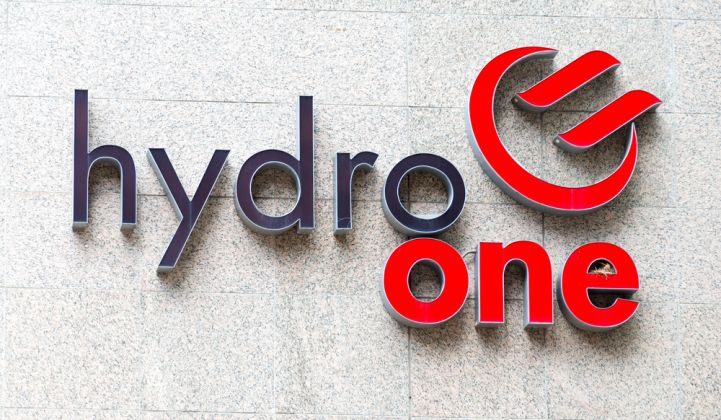Hydro One, the transmission and distribution grid utility serving Canada’s Ontario province, has issued an offer to acquire Spokane, Wash.-based electricity and gas utility Avista for $6.7 billion Canadian ($5.3 billion). It's not the first, but it is one of the biggest, cross-border acquisitions to date in the North American utility landscape.
Under terms of the deal announced last week, Hydro One will issue common equity worth $1.4 billion Canadian (USD $1.12 billion), as well as $2.6 billion Canadian in debt, to buy Avista for $53 in cash per common share, a 24 percent premium from the previous day’s market close. The deal, expected to close in mid-2018, will create a company with $32.2 billion Canadian ($25.4 billion) in combined assets.
The resulting efficiencies of scale, plus the value of sharing IT systems and increasing purchasing power, will eliminate the need for job cuts at either company, as well as avoiding short-term price hikes for Avista’s 379,000 electricity and 342,000 natural-gas customers, the companies said. Avista operates in its home territory of eastern Washington state, as well as northeastern Oregon, parts of Idaho and Montana, and in Juneau, Alaska.
Hydro One’s offer is the biggest from Canada for a U.S. utility since the $4.7 billion purchase of Louisiana’s Cleco by a group of investors led by Macquarie Infrastructure and Real Assets and British Columbia Investment Management Corp. This merger, first proposed in 2014, was initially rejected by Louisiana state regulators over concerns of local economic impacts. Ultimately, an added $7 million in economic development funds helped to close the deal last year.
Avista’s deal will face similar scrutiny, according to the Spokane Spokesman-Review, under state regulations that require utility mergers to be “consistent with the public interest,” with a “no harm” standard. The rule was put in place as part of Puget Holdings' $7.4 billion acquisition of Puget Energy and Puget Sound Energy, which came with 78 conditions on issues ranging from rates and jobs to maintaining corporate contributions post-merger.
Meanwhile, in Canada, Ontario's conservative party leader Patrick Brown told the Toronto Sun that Hydro One should claw back proposed rate increases before spending money on acquisitions. He also slammed the Liberal-controlled government for allowing an investment in a U.S. utility that still gets about 10 percent of its energy from coal. Ontario stopped using coal completely in 2014, and has set a goal to get 50 percent of its electricity from renewable sources by 2025.
Hydro One, which serves more than 100 other utilities with about 1.3 million customers via more than 150,000 kilometers of high- and low-voltage wires, is also under pressure to perform in the public market. Through a series of initial public offerings starting in 2015, the province has raised about $9 billion Canadian ($7.2 billion) to reduce its once-complete ownership stake in the company to just under 50 percent.
Ontario’s electricity regime separates Hydro One’s transmission and distribution operations from power generation and retail energy markets. On the generating side, Ontario Power Generation, which operates about half of the province’s mix of hydropower, natural gas, wind, biomass and nuclear power, remains wholly government-owned. On the retail side, the province is divided between scores of retail and municipal providers.
Avista’s retail electricity and natural-gas business offers Hydro One exposure to retail energy and power markets in the United States, as well as a more general opportunity to grow amid broader trends of flat or declining energy growth. In that way, the proposed merger is the latest in a line of Canadian energy companies, such as Enbridge, TransCanada, Brookfield and Northern Power, looking to U.S. assets for growth.
At the same time, Hydro One has distinguished itself in facing the challenges of integrating lots of wind power at the transmission scale, as well as solar power connecting to its distribution system under the province’s lucrative feed-in tariff. To manage these challenges, the utility has been working on distribution automation, energy storage and integrating with microgrids being put together by local utility partners such as Toronto Hydro.
Avista brings its own technology smarts to bear, with smart metering, distribution automation and energy storage integration, as well as its smart city project with hometown AMI vendor Itron.
Last week's news comes amid a rising tide of ever-larger utility mergers in North America, although none have gone smoothly. The biggest of last year, Chicago-based Exelon’s $6.8 billion acquisition of Pepco’s three mid-Atlantic electric and gas utilities, was first proposed in 2014, but was rejected twice by Washington, D.C. regulators. The deal that finally passed on a 2-1 vote last year came with many promises, including a $50-per-customer credit, a pledge to continue Pepco’s microgrid projects, and a 5-megawatt solar system project that is now underway at D.C. Water.
Several other big utility mergers have been quashed in the past few years, such as NextEra Energy’s attempts to buy Texas T&D utility Oncor and its $4.3 billion bid for Hawaiian Electric Companies.



